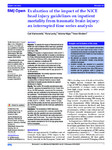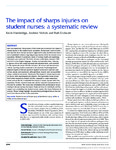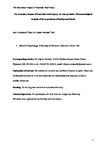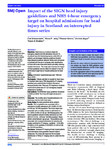Evaluation of the impact of the NICE head injury guidelines on inpatient mortality from traumatic brain injury: an interrupted time series analysis
| dc.contributor.author | Marincowitz, C | |
| dc.contributor.author | Lecky, F | |
| dc.contributor.author | Allgar, Victoria | |
| dc.contributor.author | Sheldon, T | |
| dc.date.accessioned | 2021-08-09T11:22:27Z | |
| dc.date.available | 2021-08-09T11:22:27Z | |
| dc.date.issued | 2019-06 | |
| dc.identifier.issn | 2044-6055 | |
| dc.identifier.issn | 2044-6055 | |
| dc.identifier.other | ARTN e028912 | |
| dc.identifier.uri | http://hdl.handle.net/10026.1/17473 | |
| dc.description.abstract |
<jats:sec><jats:title>Objective</jats:title><jats:p>To evaluate the impact of National Institute for Health and Care Excellence (NICE) head injury guidelines on deaths and hospital admissions caused by traumatic brain injury (TBI).</jats:p></jats:sec><jats:sec><jats:title>Setting</jats:title><jats:p>All hospitals in England between 1998 and 2017.</jats:p></jats:sec><jats:sec><jats:title>Participants</jats:title><jats:p>Patients admitted to hospital or who died up to 30 days following hospital admission with International Classification of Diseases (ICD) coding indicating the reason for admission or death was TBI.</jats:p></jats:sec><jats:sec><jats:title>Intervention</jats:title><jats:p>An interrupted time series analysis was conducted with intervention points when each of the three guidelines was introduced. Analysis was stratified by guideline recommendation specific age groups (0–15, 16–64 and 65+).</jats:p></jats:sec><jats:sec><jats:title>Outcome measures</jats:title><jats:p>The monthly population mortality and admission rates for TBI.</jats:p></jats:sec><jats:sec><jats:title>Study design</jats:title><jats:p>An interrupted time series analysis using complete Office of National Statistics cause of death data linked to hospital episode statistics for inpatient admissions in England.</jats:p></jats:sec><jats:sec><jats:title>Results</jats:title><jats:p>The monthly TBI mortality and admission rates in the 65+ age group increased from 0.5 to 1.5 and 10 to 30 per 100 000 population, respectively. The increasing mortality rate was unaffected by the introduction of any of the guidelines.</jats:p><jats:p>The introduction of the second NICE head injury guideline was associated with a significant reduction in the monthly TBI mortality rate in the 16–64 age group (-0.005; 95% CI: −0.002 to −0.007).</jats:p><jats:p>In the 0–15 age group the TBI mortality rate fell from around 0.05 to 0.01 per 100 000 population and this trend was unaffected by any guideline.</jats:p></jats:sec><jats:sec><jats:title>Conclusion</jats:title><jats:p>The introduction of NICE head injury guidelines was associated with a reduced admitted TBI mortality rate after specialist care was recommended for severe TBI. The improvement was solely observed in patients aged 16–64 years.</jats:p><jats:p>The cause of the observed increased admission and mortality rates in those 65+ and potential treatments for TBI in this age group require further investigation.</jats:p></jats:sec> | |
| dc.format.extent | e028912-e028912 | |
| dc.format.medium | Electronic | |
| dc.language | en | |
| dc.language.iso | eng | |
| dc.publisher | BMJ | |
| dc.subject | head injury | |
| dc.subject | health policy | |
| dc.subject | traumatic brain injury | |
| dc.subject | Adolescent | |
| dc.subject | Age Factors | |
| dc.subject | Aged | |
| dc.subject | Brain Injuries, Traumatic | |
| dc.subject | Craniocerebral Trauma | |
| dc.subject | England | |
| dc.subject | Female | |
| dc.subject | Hospital Mortality | |
| dc.subject | Humans | |
| dc.subject | Infant, Newborn | |
| dc.subject | International Classification of Diseases | |
| dc.subject | Interrupted Time Series Analysis | |
| dc.subject | Male | |
| dc.subject | Patient Admission | |
| dc.subject | Practice Guidelines as Topic | |
| dc.subject | Quality Improvement | |
| dc.subject | Risk Assessment | |
| dc.title | Evaluation of the impact of the NICE head injury guidelines on inpatient mortality from traumatic brain injury: an interrupted time series analysis | |
| dc.type | journal-article | |
| dc.type | Journal Article | |
| dc.type | Research Support, Non-U.S. Gov't | |
| plymouth.author-url | https://www.webofscience.com/api/gateway?GWVersion=2&SrcApp=PARTNER_APP&SrcAuth=LinksAMR&KeyUT=WOS:000471197000097&DestLinkType=FullRecord&DestApp=ALL_WOS&UsrCustomerID=11bb513d99f797142bcfeffcc58ea008 | |
| plymouth.issue | 6 | |
| plymouth.volume | 9 | |
| plymouth.publication-status | Published | |
| plymouth.journal | BMJ Open | |
| dc.identifier.doi | 10.1136/bmjopen-2019-028912 | |
| plymouth.organisational-group | /Plymouth | |
| plymouth.organisational-group | /Plymouth/Faculty of Health | |
| plymouth.organisational-group | /Plymouth/Faculty of Health/Peninsula Medical School | |
| plymouth.organisational-group | /Plymouth/REF 2021 Researchers by UoA | |
| plymouth.organisational-group | /Plymouth/REF 2021 Researchers by UoA/UoA01 Clinical Medicine | |
| plymouth.organisational-group | /Plymouth/Research Groups | |
| plymouth.organisational-group | /Plymouth/Research Groups/Plymouth Institute of Health and Care Research (PIHR) | |
| plymouth.organisational-group | /Plymouth/Users by role | |
| plymouth.organisational-group | /Plymouth/Users by role/Academics | |
| dc.publisher.place | England | |
| dc.identifier.eissn | 2044-6055 | |
| dc.rights.embargoperiod | Not known | |
| rioxxterms.versionofrecord | 10.1136/bmjopen-2019-028912 | |
| rioxxterms.licenseref.uri | http://www.rioxx.net/licenses/all-rights-reserved | |
| rioxxterms.type | Journal Article/Review |





